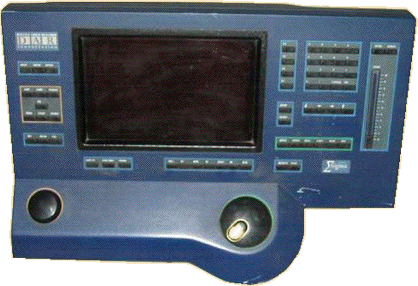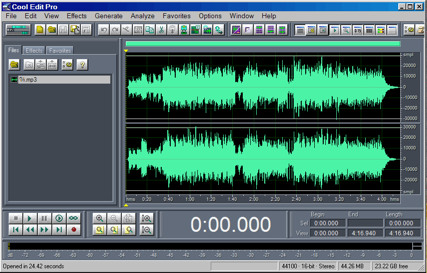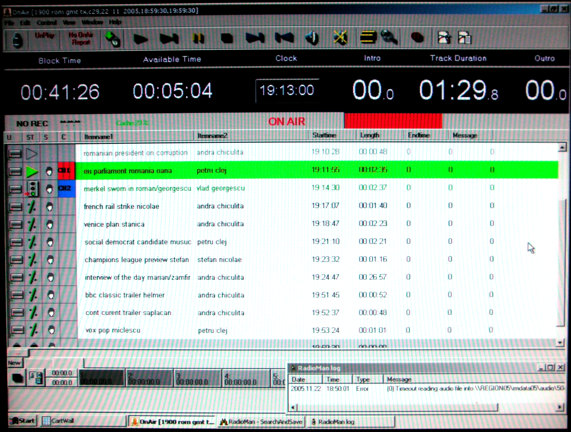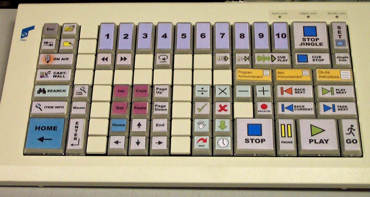

CONTENTS
1 INTRODUCTION
2 STEEL TAPE
3 OPTICAL FILM
4 DIRECTLY-CUT DISKS
5 MAGNETIC TAPE
6 PORTABLE RECORDING
7 CARTS AND DARTS
8 DIGITAL RECORDING AND PLAYOUT
Up until the 1970s all recording systems were 'analogue': the variations in voltage coming from the microphone were amplified and applied to the variable movement of a groove, the width of an optical track, or the intensity of magnetization of tape. Digital recording developed slowly at first, used in recording studios for making the master recording which would then become a gramophone record. The electrical signal representing the sound was sampled at very frequent intervals - thousands of times a second - and its level at each instant described as a number in the binary code used in computers.
The early methods often involved tape mechanisms adapted from video recorder techniques; at the beginning of the 1980s the popular Compact Disc system became available to the public, providing high quality, no wear in use, and easy use (though 'Perfect Sound Forever', as advertised, was open to debate).
When computer technology evolved to the state where this digital audio could be recorded onto a hard disk the system came into its own: now it was 'non-linear'. Tape is a linear medium - you have to spool through it to find a particular place. Gramophone records, though of course they have one continuous groove, are non-linear to the extent that you can go straight to any point on a side - but obviously not editable. Hard disk systems could find any point immediately, and could move a section of the recording from one place to another; the order in which the information was recorded on the hard disk didn't matter since the machine could be instructed to play the audio in any required order - thus providing truly non-linear editing. You could cut a bit out of a recording, and if you didn't like the result, just put it back: and copying through several generations didn't degrade the quality in the way that analogue systems inevitably did.
 The
first digital editors used dedicated hardware: the first one I
saw was
the DAR SoundStation (right) which we had on demo briefly in
1989. The
display
showed a tape-like travelling waveform: where with tape we'd
moved the
tape backwards and forwards by hand to find the place (we called
it
'inching' but for some reason it's now called 'scrubbing') the
Soundstation had a wheel with an indent for your finger (oddly
called a
'thumbwheel' though you would be unlikely to use your thumb);
rotating
this felt very much like moving tape. You marked the start and
end of
the edit with a button, hit delete, and your edit was done (and
undoable). It was a glimpse of a completely different method of
working, and a very attractive one.
The
first digital editors used dedicated hardware: the first one I
saw was
the DAR SoundStation (right) which we had on demo briefly in
1989. The
display
showed a tape-like travelling waveform: where with tape we'd
moved the
tape backwards and forwards by hand to find the place (we called
it
'inching' but for some reason it's now called 'scrubbing') the
Soundstation had a wheel with an indent for your finger (oddly
called a
'thumbwheel' though you would be unlikely to use your thumb);
rotating
this felt very much like moving tape. You marked the start and
end of
the edit with a button, hit delete, and your edit was done (and
undoable). It was a glimpse of a completely different method of
working, and a very attractive one.
We never actually used the SoundStation: we did have one AMS AudioFile, which was similar but much more complex (and not very user-friendly) - it was used for assembling radio plays piecemeal in much the same way that film sound editing was done, but of course the results had to be copied to tape in real time so that they could be played out on-air.
Only when personal computers and networks with central servers became powerful enough to handle large amounts of audio (and pump it round a large building) did digital audio really come into its own for broadcasting. There were many competing systems, and I'm not going to attempt to discuss them here - the World Service experience gives a good idea of how the process developed.
 The
first method to go into use was digital recording and editing
using a
computer screen, with programs such as Cool Edit (left) (which
later
became Adobe Audition). By using the mouse to select parts of
the
waveform, edits could be made: though 'scrubbing' wasn't
practicable -
one became adept at finding the place by eye. Of course edits
could
easily be checked and remade if necessary. Other systems were in
use,
particularly the very complex SADiE,
which had its own hardware (and a very steep learning curve).
The
first method to go into use was digital recording and editing
using a
computer screen, with programs such as Cool Edit (left) (which
later
became Adobe Audition). By using the mouse to select parts of
the
waveform, edits could be made: though 'scrubbing' wasn't
practicable -
one became adept at finding the place by eye. Of course edits
could
easily be checked and remade if necessary. Other systems were in
use,
particularly the very complex SADiE,
which had its own hardware (and a very steep learning curve).
This was still a localized system: the results still had to be copied to tape to go to the studio. The development which made all the difference was the use of a central server, and PCs ('workstations') in each studio and office, so that recordings once made in one studio were available to edit or play out anywhere else (though there was usually a permissions method to restrict access to those who should have it).

A number of systems were tried
over several years, including Dave 2000, Netia and DaCapo before
Jutel's RadioMan
was decided on (on factors which included not only usability but
support and availability): it came into use from 2004 (though
News
decided to stick with Dave 2000, which they had been using for
some
time). As before,
recordings would be made in a studio on a local PC , then saved
to
the server. The producer could tinker with his programme to his
heart's content in his office: then for transmission the
producer would
assemble a playlist (above) which could be accessed in the
studio.
It's important to understand that the items in the playlist are not the actual recordings, just pointers to them. If you delete an item from the playlist you don't delete the original recording; items can be added, deleted, or moved around in the running order very easily, so there is complete flexibility in organizing the transmission. It's possible to 'chain' items if desired, and a countdown to the end is shown. Items turn up on alternating faders (so you do need to be clear which fader is next) which means that one item can be faded under the next; you can even check the end of an item which is currently playing.
Like any new system, there were teething problems. (Tape had been around for so long - forty years - that there was no-one who remembered the teething troubles it gave, or the previous methods.) It was possible to make operational errors that could paint you into a corner: and unlike tape, where the worst a machine can do is eat the tape which is on it at the moment, if any digital system of this sort fails it takes the entire transmission with it (and if the server or network fails the results get quite exciting). There were backup procedures, but inevitably there were difficulties at first.
 Control
of the items is done from keys on the desk, a mouse and standard
keyboard, or from
a dedicated control pad which gives access to all the important
facilities (right).
Control
of the items is done from keys on the desk, a mouse and standard
keyboard, or from
a dedicated control pad which gives access to all the important
facilities (right).
Once fully installed and running, this system makes a huge change in the way broadcasting can be done. Recordings don't have to be physically carried round the building: a producer in his office can amend the running order of a transmission currently on-air; and complete assembly of programmes from the component items can be done in an office on headphones (not always with desirable results).
One issue is that non-technical staff, watching an experienced operator doing tape editing at a very fast speed, are impressed by the appearance of this and think it's the difficult bit: give an untrained producer a computer editing system and he can do just as well. Of course, the important thing is knowing where to cut, not how fast you can do it - it's vital to maintain the natural pace of edited speech, avoiding over-short pauses, double breaths, and so on: I've heard any amount of bad editing as a result of these developments (which is a failing in training rather than the equipment itself).

However on the whole it proved a valuable method to replace tape. The photo above shows a small studio equipped with RadioMan; at the time it was taken the older technology still hadn't been removed (CD players would always be necessary, but Darts and Minidiscs were by then no longer in use). With the closure of Bush House in 2012 and the move to the new Broadcasting House I understand that a different playout system is now in use but the general principles will be the same.
So we've seen the development from no recording at all, through steel tape, discs and modern magnetic tape to a centralized system where recordings can be immediately available anywhere required. I offer no predictions on what will come next.
1 INTRODUCTION
2 STEEL TAPE
3 OPTICAL FILM
4 DIRECTLY-CUT DISKS
5 MAGNETIC TAPE
6 PORTABLE RECORDING
7 CARTS AND DARTS
8 DIGITAL RECORDING AND PLAYOUT

Up until the 1970s all recording systems were 'analogue': the variations in voltage coming from the microphone were amplified and applied to the variable movement of a groove, the width of an optical track, or the intensity of magnetization of tape. Digital recording developed slowly at first, used in recording studios for making the master recording which would then become a gramophone record. The electrical signal representing the sound was sampled at very frequent intervals - thousands of times a second - and its level at each instant described as a number in the binary code used in computers.
The early methods often involved tape mechanisms adapted from video recorder techniques; at the beginning of the 1980s the popular Compact Disc system became available to the public, providing high quality, no wear in use, and easy use (though 'Perfect Sound Forever', as advertised, was open to debate).
When computer technology evolved to the state where this digital audio could be recorded onto a hard disk the system came into its own: now it was 'non-linear'. Tape is a linear medium - you have to spool through it to find a particular place. Gramophone records, though of course they have one continuous groove, are non-linear to the extent that you can go straight to any point on a side - but obviously not editable. Hard disk systems could find any point immediately, and could move a section of the recording from one place to another; the order in which the information was recorded on the hard disk didn't matter since the machine could be instructed to play the audio in any required order - thus providing truly non-linear editing. You could cut a bit out of a recording, and if you didn't like the result, just put it back: and copying through several generations didn't degrade the quality in the way that analogue systems inevitably did.
 The
first digital editors used dedicated hardware: the first one I
saw was
the DAR SoundStation (right) which we had on demo briefly in
1989. The
display
showed a tape-like travelling waveform: where with tape we'd
moved the
tape backwards and forwards by hand to find the place (we called
it
'inching' but for some reason it's now called 'scrubbing') the
Soundstation had a wheel with an indent for your finger (oddly
called a
'thumbwheel' though you would be unlikely to use your thumb);
rotating
this felt very much like moving tape. You marked the start and
end of
the edit with a button, hit delete, and your edit was done (and
undoable). It was a glimpse of a completely different method of
working, and a very attractive one.
The
first digital editors used dedicated hardware: the first one I
saw was
the DAR SoundStation (right) which we had on demo briefly in
1989. The
display
showed a tape-like travelling waveform: where with tape we'd
moved the
tape backwards and forwards by hand to find the place (we called
it
'inching' but for some reason it's now called 'scrubbing') the
Soundstation had a wheel with an indent for your finger (oddly
called a
'thumbwheel' though you would be unlikely to use your thumb);
rotating
this felt very much like moving tape. You marked the start and
end of
the edit with a button, hit delete, and your edit was done (and
undoable). It was a glimpse of a completely different method of
working, and a very attractive one.We never actually used the SoundStation: we did have one AMS AudioFile, which was similar but much more complex (and not very user-friendly) - it was used for assembling radio plays piecemeal in much the same way that film sound editing was done, but of course the results had to be copied to tape in real time so that they could be played out on-air.
Only when personal computers and networks with central servers became powerful enough to handle large amounts of audio (and pump it round a large building) did digital audio really come into its own for broadcasting. There were many competing systems, and I'm not going to attempt to discuss them here - the World Service experience gives a good idea of how the process developed.
 The
first method to go into use was digital recording and editing
using a
computer screen, with programs such as Cool Edit (left) (which
later
became Adobe Audition). By using the mouse to select parts of
the
waveform, edits could be made: though 'scrubbing' wasn't
practicable -
one became adept at finding the place by eye. Of course edits
could
easily be checked and remade if necessary. Other systems were in
use,
particularly the very complex SADiE,
which had its own hardware (and a very steep learning curve).
The
first method to go into use was digital recording and editing
using a
computer screen, with programs such as Cool Edit (left) (which
later
became Adobe Audition). By using the mouse to select parts of
the
waveform, edits could be made: though 'scrubbing' wasn't
practicable -
one became adept at finding the place by eye. Of course edits
could
easily be checked and remade if necessary. Other systems were in
use,
particularly the very complex SADiE,
which had its own hardware (and a very steep learning curve).This was still a localized system: the results still had to be copied to tape to go to the studio. The development which made all the difference was the use of a central server, and PCs ('workstations') in each studio and office, so that recordings once made in one studio were available to edit or play out anywhere else (though there was usually a permissions method to restrict access to those who should have it).

It's important to understand that the items in the playlist are not the actual recordings, just pointers to them. If you delete an item from the playlist you don't delete the original recording; items can be added, deleted, or moved around in the running order very easily, so there is complete flexibility in organizing the transmission. It's possible to 'chain' items if desired, and a countdown to the end is shown. Items turn up on alternating faders (so you do need to be clear which fader is next) which means that one item can be faded under the next; you can even check the end of an item which is currently playing.
Like any new system, there were teething problems. (Tape had been around for so long - forty years - that there was no-one who remembered the teething troubles it gave, or the previous methods.) It was possible to make operational errors that could paint you into a corner: and unlike tape, where the worst a machine can do is eat the tape which is on it at the moment, if any digital system of this sort fails it takes the entire transmission with it (and if the server or network fails the results get quite exciting). There were backup procedures, but inevitably there were difficulties at first.
 Control
of the items is done from keys on the desk, a mouse and standard
keyboard, or from
a dedicated control pad which gives access to all the important
facilities (right).
Control
of the items is done from keys on the desk, a mouse and standard
keyboard, or from
a dedicated control pad which gives access to all the important
facilities (right).Once fully installed and running, this system makes a huge change in the way broadcasting can be done. Recordings don't have to be physically carried round the building: a producer in his office can amend the running order of a transmission currently on-air; and complete assembly of programmes from the component items can be done in an office on headphones (not always with desirable results).
One issue is that non-technical staff, watching an experienced operator doing tape editing at a very fast speed, are impressed by the appearance of this and think it's the difficult bit: give an untrained producer a computer editing system and he can do just as well. Of course, the important thing is knowing where to cut, not how fast you can do it - it's vital to maintain the natural pace of edited speech, avoiding over-short pauses, double breaths, and so on: I've heard any amount of bad editing as a result of these developments (which is a failing in training rather than the equipment itself).

However on the whole it proved a valuable method to replace tape. The photo above shows a small studio equipped with RadioMan; at the time it was taken the older technology still hadn't been removed (CD players would always be necessary, but Darts and Minidiscs were by then no longer in use). With the closure of Bush House in 2012 and the move to the new Broadcasting House I understand that a different playout system is now in use but the general principles will be the same.
So we've seen the development from no recording at all, through steel tape, discs and modern magnetic tape to a centralized system where recordings can be immediately available anywhere required. I offer no predictions on what will come next.



